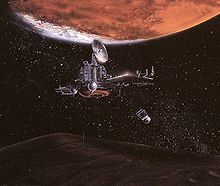Fobos
Fobos 1 and Fobos 2 ( Russian Фобос ) were two Soviet space probes from 1988. The probes were supposed to explore the Martian moon Phobos . However, both were lost before reaching their destination.
mission
The aim of the project was to send two probes into orbit around Mars for about a month. After that, both orbiters should head for the Martian moon Phobos, orbit it and drop a landing unit and a "Springer" (only Fobos 2). As a partner, the Soviet Union brought the (at that time still purely Western European) ESA on board, an expression of perestroika under Gorbachev . In addition, an Eastern Bloc state was also involved in the GDR .
According to NASA , the mission objectives of Fobos 1 and Fobos 2 were:
- Studies of interplanetary space,
- Solar observations,
- Investigation of the plasma in the vicinity of Mars,
- Atmospheric and surface studies of Mars,
- Investigation of the surface composition of the Martian moon Phobos.
course
Fobos 1
| Fobos 1 | |||||||
|---|---|---|---|---|---|---|---|
| NSSDC ID | 1988-058A | ||||||
| Launcher | Proton-K | ||||||
| construction | |||||||
| Takeoff mass | 6220 kg | ||||||
| Course of the mission | |||||||
| Start date | July 7, 1988 | ||||||
| launch pad | Baikonur Cosmodrome , Soviet Union | ||||||
|
|||||||
On July 7, 1988 Fobos 1 was mixed with a carrier rocket of the type Proton-K from the Baikonur Cosmodrome launched from, but contact with this probe broke off already on 2 September 1988th
When contacting us, a code was accidentally transmitted a few days earlier, which falsely switched off the control engines. As the solar cells were no longer aligned with the sun, the batteries were exhausted.
Fobos 2
| Fobos 2 | ||||||||||
|---|---|---|---|---|---|---|---|---|---|---|
| NSSDC ID | 1989-059A | |||||||||
| Launcher | Proton-K | |||||||||
| construction | ||||||||||
| Takeoff mass | 2600 kg | |||||||||
| Course of the mission | ||||||||||
| Start date | July 12, 1988 | |||||||||
| launch pad | Baikonur Cosmodrome , Soviet Union | |||||||||
|
||||||||||
The sister probe Fobos 2 was also launched from Baikonur with a Proton-K on July 12, 1988 and reached a Mars orbit on January 28, 1989. Some data and images from Mars were transmitted to Earth before the probe headed for Phobos. Shortly before the rendezvous , contact was broken on March 27, 1989. What remained were the measurement results and detailed recordings of Phobos collected up to that point.
Fobos 2 was the last planetary space mission of the Soviet Union. Further planned missions were canceled due to the upheaval in the Eastern Bloc after 1989.
See also
literature
- Sagdeev, RZ, et al .: The Phobos project: Scientific objectives and experimental methods , Sov. Sci. Rev. E. Astrophys. Space Phys., 6, Pt. 1, 1-60, Aug. 1988.
- RJL Grard & RG Marsden: The Phobos Mission: First Results from the Plasma-Wave System and Low-Energy Telescope , ESA Bulletin 56, November 1988, ISSN 0376-4265 , page 81.
- RJL Grard: First Results from ESA's Plasma-Wave System aboard Phobos , ESA-Bulletin 59, August 1989, ISSN 0376-4265 , page 31.
Web links
- Phobos mission on the side of the Institute of Space Research of the Russian Academy of Sciences (English)
- Phobos 1 + 2
- Fobos 1F in the Encyclopedia Astronautica (English)
Individual evidence
- ↑ a b c d e f g Phobos 1 in the NSSDCA Master Catalog , accessed on December 23, 2015 (English).
- ↑ a b c d e Phobos 2 in the NSSDCA Master Catalog, accessed on December 23, 2015 (English).
- ↑ Ralph Hartley: Phobos 1 & 2 computer failures. In: SCIENCE Vol 245. SCIENCE, September 8, 1989, p. 1045 , accessed on May 13, 2009 (English).


